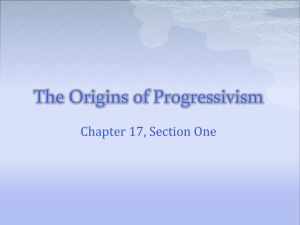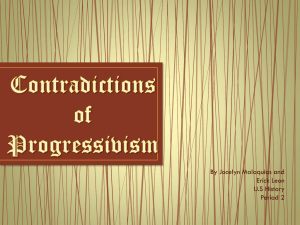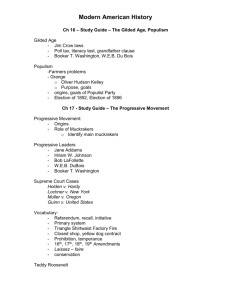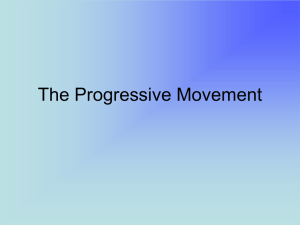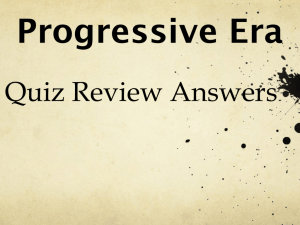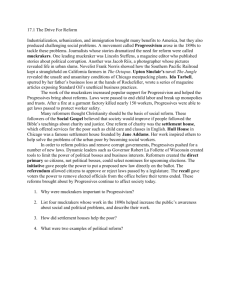Progressive Era
advertisement
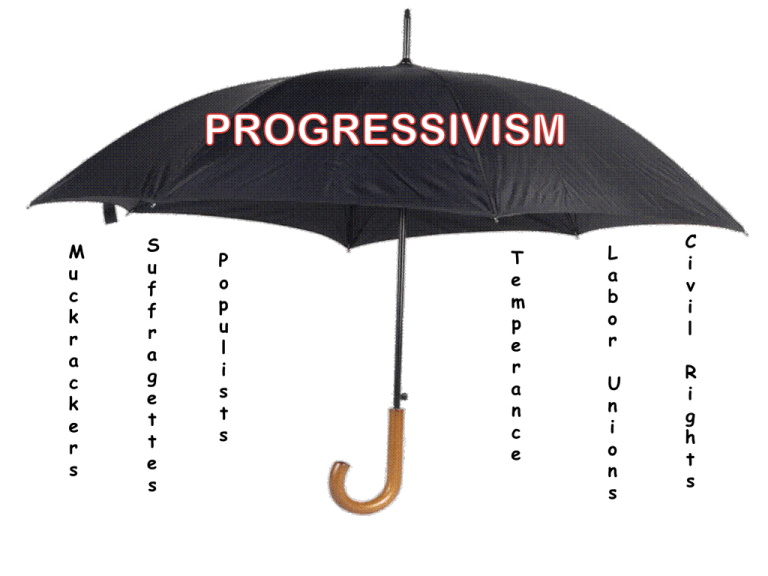
M u c k r a c k e r s S u f f r a g e t t e s P o p u l i s t s T e m p e r a n c e L a b o r U n i o n s C i v i l R i g h t s The “Culture Wars”: The Pendulum of Right v. Left 2nd Great Awakening Social Gospel 1920s Revivalism 1950s Revivalism Christian Evangelical Movement C I V I L W A R Antebellum Reforms [1810s1850s] Populism [1870s1890s] Progressivism [1890s-1920] New Deal [1930s1940s] Great Society & 1960s Social Movements C O N S E R V A T I V E R E V O L U T I O N Progressive Era • Why it matters: Industrialization, urbanization, and immigration brought man benefits to America, but they also produced challenging social problems. • In response, a movement called Progressivism emerged in the 1890’s. Progressives believed that new ideas and honest, efficient government could bring about social justice. Progressive ideas brought lasting reforms that still affect society today. Origins of Progressivism • Multiple walks of life – Different political parties, social classes, ethnic groups, religions – A lot of them were from the middle class or dissatisfied industrial workers. Origins of Progressivism • Common beliefs – Industrialization and urbanization had created troubling social and political problems. – Progressives wanted to bring about reforms that would correct these problems and injustices. – They encouraged their state legislatures and the federal gov’t. to enact laws to address the issues faced by the poor. – Wanted to use logic and reason to make society work in a more efficient and orderly way. Progressivism v. Populism • Similarities – Both wanted political reform to get rid of corrupt gov’t. officials and make gov’t. more responsive to people’s needs. – Both sought to eliminate the abuses of big business. • Differences – Progressive • Middle class • Believed in highly educated leaders that should use modern ideas and scientific techniques to improve society. – Populism • Consisted mostly of farmers and workers. Target a variety of problems • Women – Gaining the right to vote= # 1 priority • Reformers targeted city officials who built corrupt organizations, called political machines. – The bosses of these political machines used bribery and violence to influence voters and win elections. – They counted on the loyalty of city workers who looked the other way when they took money for themselves. • People living in crowded cities needed paved streets, safe drinking H2O, decent housing. Trust busting • Some worried about big business – Wealthy industrialists took over businesses and built huge trusts that limited competition and raised prices. – Middle class wanted the gov’t. to bust the trusts and therefore create more economic opportunities for small businesses. • Closing the gap – Some wanted to close the gap between rich and poor. – Mostly motivated by religion. – Attacked the harsh conditions of miners, factory workers. – They wanted better living conditions for inner cities. – Strived for social welfare laws to help children. Muckrakers • Socially conscious journalists and other writers dramatized the need for reform – Sensational investigative reporting uncovered a wide range of problems. • Teddy Roosevelt nicknamed these journalists muckrakers because they were too fascinated with the ugly side of things. – A muckraker is a tool used to clean manure and hay out of animal’s stables. Novelists Defend • Fiction writers put a human face on social problems. – They portrayed human misery and developed a new genrenaturalism. • The Jungle by Upton Sinclair – Related the despair of immigrants working in Chicago’s stockyards and revealed the unsanitary conditions. Settlement Houses • Settlement House= a community center that provided social services to the urban poor. – Gave mothers classes in child care and taught English to immigrants. – The ran nursery schools and kindergartens. – They provided theater, art, and dance programs for adults. • Jane Addams became the leading figure in the settlement house. – Opened Hull House near Chicago. – Included 13 buildings. – By 1911, the country had more than 400 settlement houses. Improving Education • Florence Kelley – Lawyer that helped convince the state of Illinois to ban child labor, and other states soon followed. – 1902- Kelley formed the National Child Labor Committee which led the federal gov’t. to create the U.S. Children’s Bureau. • Congress banned child labor officially in 1916. – Keating-Owens Act – Required children to attend school until a certain age. • Some argued they should only be taught work skills. • Some argued they should learn literature and music. • Some argued girls should learn different content than boys. Work Hazards • Each year, about 30,000 workers died on the job due to hazards. – 500,000 were injured each year • Triangle Shirtwaist Factory, NYC – A factory fire – Workers had little chance to escape the fire because managers had locked most of the exits. – 146 died, most of them young Jewish women. – Many jumped from the windows in desperation. Government • 1900, Galveston, TX was torn apart by a hurricane. – Killed more than 8,000 people. – Galveston replaced the mayor and also put in a 5 person committee. • This form of gov’t. proved very efficient and carried out reform and rebuilt the city. • Known as the Galveston Plan, 500 other cities adopted this example for their own cities. • Party leaders traditionally picked candidates for state and local offices. • • • • – Wisconsin established a direct primary, an election in which citizens themselves vote to select nominees for upcoming elections. – By 1916, all but four states had direct primaries. Initiative- gave people the power to put a proposed new law directly on the ballot in the next election by collecting citizen’s signatures on a petition. Referendum- allowed citizens to approve or reject laws passed by a legislature. Recall- gave voters the power to remove public servants from office before their terms ended. 17th Amendment- 1913, direct election of senators by voters, not state legislatures. Election Reform Progressive Politicians • Theodore RooseveltNew York Governor – Roosevelt worked to develop a fair system for hiring state workers and made some corporations pay taxes. – Wanted wildlife reform. • Woodrow Wilson- New Jersey Governor – Wilson reduced the railroad’s power and pushed for a direct primary law. • Both will bring Progressive reform to the White House during their presidency.
